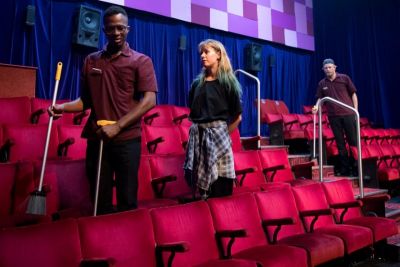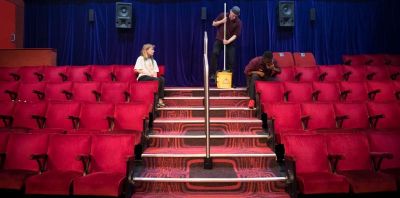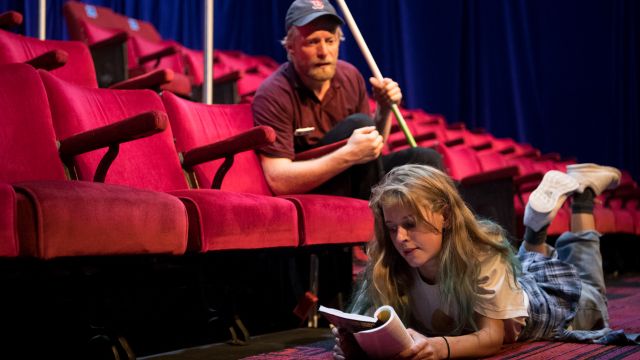The Flick
The raked seating of the Reginald Theatre is mirrored by a similar rake of red plush seating. Red and black cinema style carpet stretches up steps to an aisle. Above it, in a high, dark-curtained wall are the windows of the projection box of The Flick, a cinema in Worcester, Massachusetts. Both theatre and cinema black out simultaneously. Loud music heralds the credits of a movie. Lights come up on the empty cinema, littered with spilt popcorn.
The striking verisimilitude of Hugh O’Connor’s set matches the plausible verisimilitude of this most unusual play. It’s long (three hours), but it’s persuasively real. Characters stand in still contemplation. Pauses stretch. Dialogue falters. It is a cunning writer who demands so many silent moments; a brave director who follows those demands so conscientiously. But for this play it’s essential – and it works. It won an Obie for playwright Annie Baker in 2013, and the Pulitzer Prize for Drama in 2014 – and this production, in the very experienced directorial hands of Craig Baldwin, treats it with care and integrity.
The play follows the everyday work routine of three cinema workers. Sam, in his thirties, has been in the job for twenty years. He’s a plodder, to whom the monotony of the routine has become second nature, but he’d love to learn to run the projector. Rose is the projectionist, younger than Sam, pretty, outwardly self-contained, but a little remote. Avery is a twenty-year-old college student and movie buff who hates the “cold clarity” of digital movies. He has taken the job over the summer break because this one of the last cinemas showing 35mm film.

The play evolves as they clean the cinema after regular movies sessions. With brooms and long handled dust pans, they sweep up spilt popcorn and pick up discarded snack packets. Sometimes they mop over the carpet. The repetitive scenes are transitioned by brief black outs, flickering light from the projection box and aisle lights, the clicking of the projector itself and theme music as credits role.
Coined a “comedy of the mundane”, the play has touches of Beckett and Pinter – and requires similar timing, intricate control and subtle characterisation. All of which Baldwin has achieved. The timing is meticulous. The characters speak in halting dialogue, broken by pauses that are exasperatingly long … but maddeningly natural. They are the basis of the carefully controlled tension that is integral to this production: tension between the characters themselves, and between the characters and the audience.
Baldwin writes in his program notes: “... like the crackles of dust and the flickers of scratches on aging film, we are unpredictable, flawed, contradictory characters…”. As are the characters in Annie Baker’s play. Though they share their feelings in mundane snippets of conversation, their insecurities and frailties are revealed even more clearly in thoughtful silences and frozen actions.
 Jeremy Waters is ponderously slow-thinking as Sam. He sweeps industriously, but reacts unhurriedly. Yet he says much about the character in the way he stops to think, stationary, head to one side, almost seeming to lose track of the conversation. His insights though, are perceptive, those of a simple man who knows he could have done better. He envies Rose’s promotion to projector operator, Avery’s wide movie knowledge and education. Yet the Sam he portrays is also kind, generous, understanding in unusual ways.
Jeremy Waters is ponderously slow-thinking as Sam. He sweeps industriously, but reacts unhurriedly. Yet he says much about the character in the way he stops to think, stationary, head to one side, almost seeming to lose track of the conversation. His insights though, are perceptive, those of a simple man who knows he could have done better. He envies Rose’s promotion to projector operator, Avery’s wide movie knowledge and education. Yet the Sam he portrays is also kind, generous, understanding in unusual ways.
Justin Amankwah plays the reticent Avery. Shy, just a little nervous, he fumbles with the unaccustomed action of the long-handled dust pan, fiddles with his glasses as he reacts to a question, hesitates when Sam and Rose suggest creaming a little of the profits. He also brings to the play the bitterness and apprehension of racism. Only when he talks about movies or his dislike of digital films does he becomes more animated, more assured.

As Rose, Mia Lethbrigde watches carefully, taking stock of others but giving away little of herself – except in a short, wild dance scene that exposes some of the person she hides. She is lithe and flexible, her looseness a contrast to Sam’s dogged deliberation, Avery’s restraint. Yet she too, lacks confidence. She fiddles nervously with her hair, walks away from confrontations, even those she initiates.
Caught in the rarefied atmosphere of an empty theatre, their characters inter-react in very natural and sometimes irritating ways, yet the audience watches compulsively, waiting for the silences to break, feeling the inner tension of the characters, identifying with their frustrations. All three roles require enormous control and constant constraint. As Baldwin notes:
“Connecting with the fullness of each other’s humanity takes time … it takes investment, patience and detailed care” – all of which Baldwin and his cast have given to this long, very intense but compelling production.
Carol Wimmer
Photographer: Marnya Rothe
Subscribe to our E-Newsletter, buy our latest print edition or find a Performing Arts book at Book Nook.

